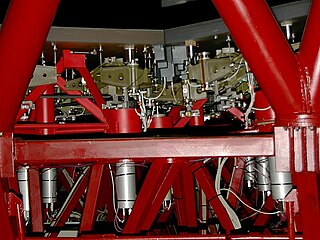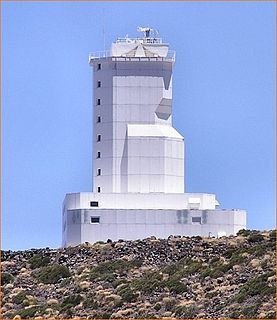
Optics is the branch of physics that studies the behaviour and properties of light, including its interactions with matter and the construction of instruments that use or detect it. Optics usually describes the behaviour of visible, ultraviolet, and infrared light. Because light is an electromagnetic wave, other forms of electromagnetic radiation such as X-rays, microwaves, and radio waves exhibit similar properties.
The focal length of an optical system is a measure of how strongly the system converges or diverges light. For an optical system in air, it is the distance over which initially collimated (parallel) rays are brought to a focus. A system with a shorter focal length has greater optical power than one with a long focal length; that is, it bends the rays more sharply, bringing them to a focus in a shorter distance.

The Very Large Telescope (VLT) is a telescope facility operated by the European Southern Observatory on Cerro Paranal in the Atacama Desert of northern Chile. The VLT consists of four individual telescopes, each with a primary mirror 8.2 m across, which are generally used separately but can be used together to achieve very high angular resolution. The four separate optical telescopes are known as Antu, Kueyen, Melipal, and Yepun, which are all words for astronomical objects in the Mapuche language. The telescopes form an array which is complemented by four movable Auxiliary Telescopes (ATs) of 1.8 m aperture.

Subaru Telescope is the 8.2-meter (320 in) flagship telescope of the National Astronomical Observatory of Japan, located at the Mauna Kea Observatory on Hawaii. It is named after the open star cluster known in English as the Pleiades. It had the largest monolithic primary mirror in the world from its commission until 2005.

The Large Binocular Telescope (LBT) is an optical telescope for astronomy located on 10,700-foot (3,300 m) Mount Graham, in the Pinaleno Mountains of southeastern Arizona, United States. It is a part of the Mount Graham International Observatory. The LBT is currently one of the world's most advanced optical telescopes; using two 8.4 m (330 inch) wide mirrors, with centres 14.4 m apart, it has the same light-gathering ability as an 11.8 m (464 inch) wide single circular telescope and detail of a 22.8 m (897 inch) wide one. Its mirrors individually are the joint second-largest optical telescope in continental North America, behind the Hobby–Eberly Telescope in West Texas; it is also the largest monolithic, or non-segmented mirror, in an optical telescope. Strehl ratios of 60–90% in the infrared H band and 95% in the infrared M band have been achieved by the LBT.

Active optics is a technology used with reflecting telescopes developed in the 1980s, which actively shapes a telescope's mirrors to prevent deformation due to external influences such as wind, temperature, mechanical stress. Without active optics, the construction of 8 metre class telescopes is not possible, nor would telescopes with segmented mirrors be feasible.

Thin-film optics is the branch of optics that deals with very thin structured layers of different materials. In order to exhibit thin-film optics, the thickness of the layers of material must be on the order of the wavelengths of visible light. Layers at this scale can have remarkable reflective properties due to light wave interference and the difference in refractive index between the layers, the air, and the substrate. These effects alter the way the optic reflects and transmits light. This effect, known as thin-film interference, is observable in soap bubbles and oil slicks.

Scanning laser ophthalmoscopy (SLO) is a method of examination of the eye. It uses the technique of confocal laser scanning microscopy for diagnostic imaging of retina or cornea of the human eye.

In geometrical optics, a focus, also called an image point, is the point where light rays originating from a point on the object converge. Although the focus is conceptually a point, physically the focus has a spatial extent, called the blur circle. This non-ideal focusing may be caused by aberrations of the imaging optics. In the absence of significant aberrations, the smallest possible blur circle is the Airy disc, which is caused by diffraction from the optical system's aperture. Aberrations tend to get worse as the aperture diameter increases, while the Airy circle is smallest for large apertures.

The Extremely Large Telescope (ELT) is an astronomical observatory and the world's largest optical/near-infrared extremely large telescope now under construction. Part of the European Southern Observatory (ESO) agency, it is located on top of Cerro Armazones in the Atacama Desert of northern Chile. The design consists of a reflecting telescope with a 39.3-metre-diameter (130-foot) segmented primary mirror and a 4.2 m (14 ft) diameter secondary mirror, and will be supported by adaptive optics, eight laser guide star units and multiple large science instruments. The observatory aims to gather 100 million times more light than the human eye, 13 times more light than the largest optical telescopes existing in 2014, and be able to correct for atmospheric distortion. It has around 256 times the light gathering area of the Hubble Space Telescope and, according to the ELT's specifications, would provide images 16 times sharper than those from Hubble. The project was originally called the European Extremely Large Telescope (E-ELT), but the name was shortened in 2017.

The MMT Observatory (MMTO) is an astronomical observatory on the site of Fred Lawrence Whipple Observatory. The Whipple observatory complex is located on Mount Hopkins, Arizona, US in the Santa Rita Mountains. The observatory is run by the University of Arizona and the Smithsonian Institution, and has a visitor center in nearby Amado, Arizona. The MMTO is the home of the MMT, which currently has a primary mirror 6.5 m in diameter. The name originally comes from the fact that the light gathering for the telescope was done by six smaller mirrors before the current primary mirror was installed. The current mirror has a special lightweight honeycomb design made by the University of Arizona's Steward Observatory Mirror Laboratory. The MMT is housed in a building which allows the walls and roof around the telescope to be completely rolled back, allowing it to cool down very quickly in order to improve the seeing.

The C. Donald Shane telescope is a 120-inch (3.0-meter) reflecting telescope located at the Lick Observatory in San Jose, California. It was named after astronomer C. Donald Shane in 1978, who led the effort to acquire the necessary funds from the California Legislature, and who then oversaw the telescope's construction. It is the largest and most powerful telescope at the Lick Observatory, and was the second-largest telescope in the world when it was commissioned in 1959.

Deformable mirrors (DM) are mirrors whose surface can be deformed, in order to achieve wavefront control and correction of optical aberrations. Deformable mirrors are used in combination with wavefront sensors and real-time control systems in adaptive optics. In 2006 they found a new use in femtosecond pulse shaping.
A wavefront sensor is a device for measuring the aberrations of an optical wavefront. Although an amplitude splitting interferometer such as the Michelson interferometer could be called a wavefront sensor, the term is normally applied to instruments that do not require an unaberrated reference beam to interfere with. They are commonly used in adaptive optics systems, lens testing and increasingly in ophthalmology.

The Vacuum Tower Telescope is an evacuated-optics solar telescope located at the Teide Observatory on Tenerife in the Canary Islands. It is operated by the Kiepenheuer-Institut für Sonnenphysik (KIS).
Multi-conjugate Adaptive optics Demonstrator (MAD) is an instrument that allowed the European Southern Observatory's Very Large Telescope to observe celestial objects with most of the atmosphere's blurring removed. As other adaptive optics systems, it works by performing real-time corrections to the atmospheric turbulence by means of computer-controlled deformable mirrors. Its particularity is the correction over a wider field of view than previous systems, that only used a single deformable mirror.
Boston Micromachines Corporation is a US company operating out of Cambridge, Massachusetts. Boston Micromachines manufactures and develops instruments based on MEMS technology to perform open and closed-loop adaptive optics. The technology is applied in astronomy, beam shaping, vision science, retinal imaging, microscopy, laser communications, and national defense. The instruments developed at Boston Micromachines include deformable mirrors, optical modulators, and retinal imaging systems, all of which utilize adaptive optics technology to enable wavefront manipulation capabilities which enhance the quality of the final image.

Ferrofluid mirror is a type of deformable mirror with reflective liquid surface, commonly used in adaptive optics. It is made of ferrofluid and magnetic iron particles in ethylene glycol, the basis of automotive antifreeze. The ferrofluid mirror changes shape instantly when a magnetic field is applied. As the ferromagnetic particles align with the magnetic field, the liquid becomes magnetized and its surface acquires a shape governed by the equilibrium between the magnetic, gravitational and surface tension forces. Since any shapes can be produced by changing the magnetic field geometries, wavefront control and correction can be achieved.
ALPAO is a company which manufactures a range of adaptive optics products for use in research and industry, including deformable mirrors with large strokes, wavefront sensors, and adaptive optics loops. These products are designed for astronomy, vision science, microscopy, wireless optical communications, and laser applications.















